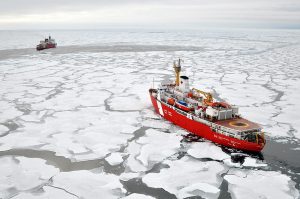The Controversy Over Arctic Shipping

ARCTIC OCEAN Ð The Canadian Coast Guard Ship Louis S. St-Laurent makes an approach to the Coast Guard Cutter Healy in the Arctic Ocean Sept. 5, 2009. The two ships are taking part in a multi-year, multi-agency Arctic survey that will help define the Arctic continental shelf.
The outlook on shipping through the Arctic is changing. And I’m not just talking about the changes in climate making shipping through the North Pole possible. Ocean freight carriers are coming out and saying just because we can ship through the Arctic doesn’t mean we should. That’s a change from the attitude the international shipping industry has had on shipping through the Arctic.
Yes, global warming and glacier melting along with ever-developing shipping technologies are opening up Arctic routes that would greatly shorten shipping distances. Shorter distances mean less fuel, time, and money spent on shipments. Certainly, expending less fuel would mean reduced pollution, so Arctic shipping must be the green way to go, right?
Not so fast.
A quick look at recent shipping headlines is enough to see that carriers are vowing not to ship through the Arctic, citing negative environmental impact as the reason. The Arctic has a fragile ecosystem that could be seriously threatened by Arctic shipping. Also, big, ice-breaking ships could speed the melting of ice caps, which could potentially impact global climate.
CMA CGM, MSC, and Hapag-Lloyd Say No to Arctic Shipping
In August, CMA CGM announced it wouldn’t ship through the Arctic for environmental reasons. In a Seatrade Maritime News article the company was quoted:
“The use of the Northern Sea Route will represent a significant danger to the unique natural ecosystems of this part of the world, mainly due to the numerous threats posed by accidents, oil pollution or collisions with marine wildlife,” CMA CGM said.
“To avoid posing a greater threat to this fragile environment, Rodolphe Saadé has decided that none of the CMA CGM Group’s 500 vessels will use the Northern Sea Route along Siberia, which is now open due to climate change.”
By October, similar sentiments were being heard from Hapag-Lloyd as quoted in another Seatrade Maritime News article:
Asked about using Arctic sea routes, Jörg Erdmann, senior director sustainability at Hapag-Lloyd, said: “Hapag-Lloyd does not use the Northwest Passage or the Northeast Passage as shipping routes right now, nor are there any plans to do so in the future.
“The particles produced by the combustion of carbon-based fossils and fuels contribute to global warming, which can in turn harm our ecosystems. As long as there are no guarantees that these passages can be navigated without negatively impacting the environment, using them is out of the question for Hapag-Lloyd, as well.”
A couple weeks ago, MSC joined the previous two ocean freight carriers in shunning Arctic shipping. Greg Knowler reported on it in a Journal of Commerce (JOC) article that includes a nice little quote from MSC on the subject:
In its rejection of the Arctic option, MSC said in a statement it was convinced the 21 million containers it transports annually could be transported around the world without passing through the northern corridor.
“As a responsible company with a longstanding nautical heritage and passion for the sea, MSC finds the disappearance of Arctic ice to be profoundly disturbing,” said Diego Aponte, president and CEO of the MSC Group.
Russia Is Pushing for Arctic Shipping
Not everyone is turning away from Arctic shipping amidst environmental concerns.
Russia, for example, is like the honey badger — it doesn’t give a [expletive censored for professionalism, damn it]. Obviously having a large stake in the Northern Sea Route, Russia is pushing for Arctic shipping. In fact, Russia is offering Arctic shipping incentives and developing a state-run containership operator.
An article in Insurance Journal by Olga Tanas and Dina Khrennikova about Russia aiming to boost Arctic shipping by subsidizing higher costs — including insurance since we’re talking about an Insurance Journal article here — highlights how hard Russia is pushing for Arctic shipping. Here are some of those highlights:
Russia wants to make its Arctic waters more attractive to shippers than the Suez Canal and could be willing to compensate for potential risks to make that happen.
…
[Russia’s Ministry of Far East and Arctic Development Alexander Krutikov], together with Russian think-tank Skolkovo, is working on a project to create a state-run container ship operator. The company would cover the cost of any risks associated with transporting international cargoes via the Arctic’s icy waters, including possible delivery disruptions and higher insurance payments.“The state pays for the Arctic exposure and the shippers cover the remaining costs themselves,” [Deputy Minister Alexander Krutikov] said in an interview. The resulting costs for shipping companies “should be lower than in the Suez Canal, at least at the first stage,” to promote the route.
…
The bulk of the 20.2 million tons of cargo which were shipped via the [Northern Sea Route] last year was LNG from Novatek PJSC’s Yamal LNG plant and crude from Gazprom Neft PJSC’s Novoportovskoye field. By 2024, Russia aims to increase shipments via the Northern Sea Route to as much as 80 million tons per year.
…
“The task is to make the Northern Sea Route safe and economically viable for shippers, attractive both in terms of quality and price,” Putin said at the international Arctic Forum in April. Russia aims to launch round-the-year navigation along the Northern Sea Route by 2030, according to Russian media reports, citing a draft of the Arctic Development program.
Year-round navigation would require a great deal of ice breaking at this point.
What Will Maersk Do?
Maersk, the world’s biggest ocean freight carrier, has been exploring Arctic shipping with Russia. Stine Jacobsen and Jacob Gronholt-Pedersen reported in a Reuters article published back in June:
… Maersk is now exploring the possibility of offering a service in cooperation with Russia’s nuclear-powered icebreaker company Rosatomflot, High North News reported on Friday.
“We have experienced growing demand for transport of goods from the Far East to West Russia, which we are currently exploring the possibilities of offering together with Atomflot,” Maersk, the world’s biggest container shipping group, confirmed in an emailed statement to Reuters.
A little over a year ago, Maersk sent the first containership of goods through the Arctic. At that time, Maersk said:
This is a trial designed to explore an unknown route for container shipping and to collect scientific data. Currently, we do not see the Northern Sea Route as an alternative to our usual routes.
Maersk has long been the most influential carrier in the ocean freight industry. Typically, as Maersk goes, so goes the rest of the carriers. It will be interesting to see if this time Maersk is the one that follows, joining CMA CGM, MSC, and Happy-Lloyd in shunning Arctic shipping.
Certainly, if Maersk does decide to denounce Arctic shipping, many other carriers will do so too. Of course, that would be a change of direction for Maersk.
China Pushes Forward in Arctic Shipping
Even if Maersk does join the trend against Arctic shipping, it is unlikely we’ll see an end of it. Not only is Russia pushing hard for Arctic shipping, but China shows no signs of slowing down in its Arctic shipping ventures. In fact, state-run carrier COSCO is really ramping up its Arctic shipping.
Malte Humpert reported earlier this year in a High North News article:
This year [COSCO] aims to conduct at least 14 transits – full voyages from Asia to Europe or vice versa – along the burgeoning [Northern Sea Route]. At least ten different vessels are scheduled to travel through the Arctic, with one vessel, Tian Hui, expected to make three full transits. This number of transits in a single year would be a first for a non-icebreaking vessel.
We were posting blogs about China shipping through the Arctic all the way back in 2012 and 2013 with the articles Freight News: China Shipping Breakthrough Could Lower Freight Rates and China is Shipping Through the Arctic!
After all these years of investing in Arctic shipping, it’s hard to imagine China would move away from it because of environmental concerns. China thinks of Arctic shipping as the new Silk Road.
Conclusion
The conclusion is there is no conclusion on Arctic shipping. There’s a building controversy. Arctic shipping has many advantages to offer shippers and shipping companies, but concerns over its environmental impact are growing.
Russia and China certainly aren’t abandoning Arctic shipping, but many major shipping companies are.
Global warming is a hot-button topic. International pressure has been placed on shipping to eliminate carbon emissions. Soon pressure may be applied to the issue of Arctic shipping. However, Arctic shipping won’t be given up without a fight.




